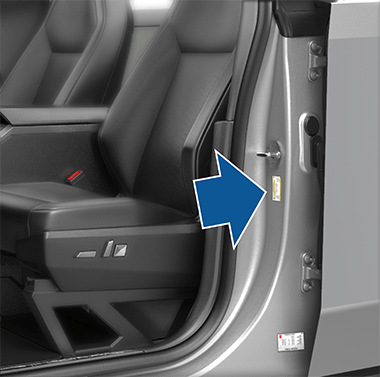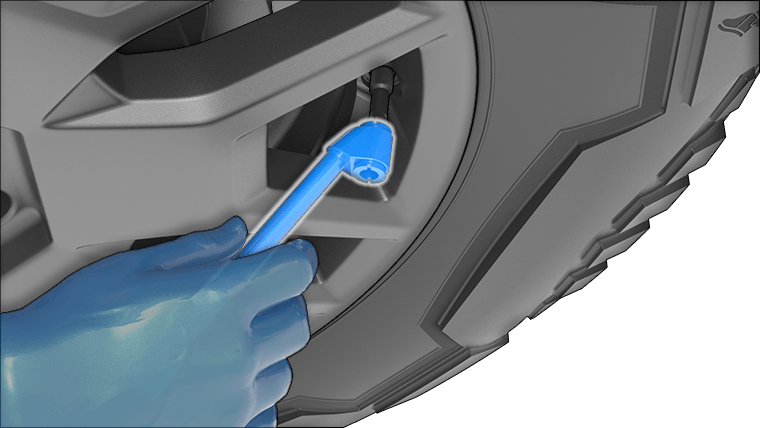Tire Pressures
Displaying Tire Pressures
Tire pressures display on the touchscreen by touching , or use the mobile app. The pressure of each tire displays in the visualization of Cybertruck, in addition to the time the tire pressures were last read by the system.
The touchscreen also displays your vehicle's recommended cold tire pressures so you can easily determine how much to inflate your tires.
To choose whether to display tire pressures using Bar or PSI, touch .
Maintaining Tire Pressures

| Tires (Front and Rear) | Normal Load* | GVWR** |
|---|---|---|
| 20" All Season | 50 psi | 50 psi |
20" All Terrain | 50 psi | 65 psi |
*Normal Load assumes a fully loaded front trunk and up to five occupants (see Steps for Determining the Correct Load Limit). | ||
If the indicator light flashes for one minute whenever you power on Cybertruck, a fault with the TPMS is detected.
Your vehicle’s tire pressures will drop in cold ambient temperatures. If the TPMS indicator light appears, inflate the tires before driving. The tires will lose approximately one PSI for every 10° F (6° C) drop in outside temperature. Proper tire pressures help protect tires from potholes and improve range and tire longevity when properly inflated.
Checking and Adjusting Tire Pressures
Follow these steps when tires are cold and Cybertruck has been stationary for over three hours:
- Refer to the Tire and Loading Information label located on the driver’s center door pillar for the target tire pressure.
- Remove the wheel cover (see Removing and Installing Wheel Covers).
- Remove the valve cap.
- Firmly press an accurate tire
pressure gauge onto the valve to measure pressure.NoteYou can also view tire pressures on the touchscreen.

- If required, add or remove air to
reach the recommended pressure.NoteYou can release air by pressing the metal stem in the center of the valve.
- Re-check pressure using the accurate tire gauge.
- Repeat steps 5 and 6 as necessary until the tire pressure is correct.
- Reinstall the valve cap to prevent dirt from entering. Periodically check the valve for damage and leaks.
- Reinstall the wheel cover.
Tire Pressure Monitoring
Each tire, including the spare (if provided), should be checked monthly when cold and inflated to the inflation pressure recommended by the vehicle manufacturer on the vehicle placard or tire inflation pressure label. (If your vehicle has tires of a different size than the size indicated on the vehicle placard or tire inflation pressure label, you should determine the proper tire inflation pressure for those tires.)
As an added safety feature, your vehicle has been equipped with a tire pressure monitoring system (TPMS) that illuminates a low tire pressure telltale when one or more of your tires is significantly under-inflated. Accordingly, when the low tire pressure telltale illuminates, you should stop and check your tires as soon as possible, and inflate them to the proper pressure. Driving on a significantly under-inflated tire causes the tire to overheat and can lead to tire failure. Under-inflation also reduces fuel efficiency and tire tread life, and may affect the vehicle's handling and stopping ability.
Please note that the TPMS is not a substitute for proper tire maintenance, and it is the driver's responsibility to maintain correct tire pressure, even if under-inflation has not reached the level to trigger illumination of the TPMS low tire pressure telltale.
TPMS Malfunction
Your vehicle has also been equipped with a TPMS malfunction indicator to indicate when the system is not operating properly. The TPMS malfunction indicator is combined with the low tire pressure telltale. When the system detects a malfunction, the telltale will flash for approximately one minute and then remain continuously illuminated. This sequence will continue upon subsequent vehicle start-ups as long as the malfunction exists.
When the malfunction indicator is illuminated, the system may not be able to detect or signal low tire pressure as intended. TPMS malfunctions may occur for a variety of reasons, including the installation of replacement or alternate tires or wheels on the vehicle that prevent the TPMS from functioning properly. Always check the TPMS malfunction telltale after replacing one or more tires or wheels on your vehicle to ensure that the replacement or alternate tires and wheels allow the TPMS to continue to function properly.
Replacing a Tire Sensor
If the Tire Pressure warning indicator displays frequently, schedule a service appointment to determine if a tire sensor needs to be replaced. Non-Tesla Service Center must replace using a Tesla OEM sensor.
